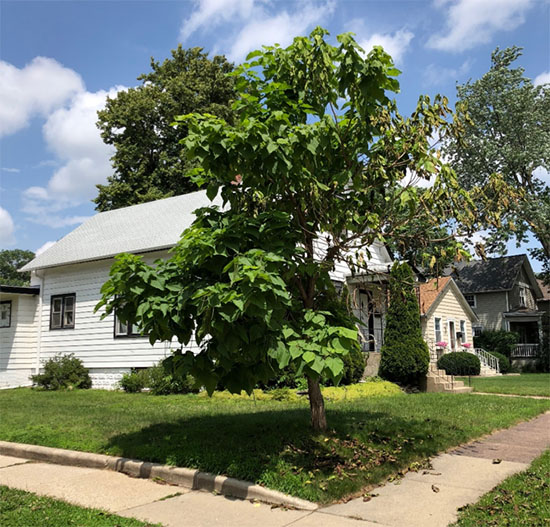Issue 11, July 16, 2018
Verticillium Wilt
Verticillium wilt is a common and serious disease that affects over 300 hosts, including woody and herbaceous plants. There are a number of species of plant pathogenic fungi in the Verticillium genus known to cause wilt disease, with different strains or pathotypes of the pathogen exhibiting definite host plant preferences. The fungus is capable of surviving in the soil for several years. Once inside the plant the fungus colonizes the vascular system, restricting water movement and leading to the decline and death of the host. The disease is most severe in Illinois during cool to warm weather, and less prevalent in hot weather.
Common susceptible woody hosts in Illinois include maple, ash, elm, redbud, smoke trees, tulip trees, and oak trees in the red oak group. A common symptom in woody hosts is flagging, where the foliage on an individual branch suddenly wilts and dies. Often, the foliage on only one side of the tree or shrub wilts. An overall yellowing of the leaves may precede the wilting. Some hosts (such as ash) may defoliate while still green and without any yellowing or wilting. Symptoms are most often seen in Illinois starting in early July, though they may begin as early as March and continue through November.

Catalpa tree displaying symptoms of Verticillium wilt.
Environmental factors influence the severity of symptoms. Woody plants under stress due to drought, nutrient deficiencies, or salt toxicities are more extensively invaded by the fungus. Hosts may decline and die rapidly within a few weeks of symptom development, or they may linger through many seasons getting progressively weaker due to branch dieback.
To confirm the presence of Verticillium wilt in a suspected host, a sample of a symptomatic branch (one showing yellowing or wilting leaves, but not completely dead) should be sent to a plant diagnostic laboratory. The branch should ideally be 8‐10 inches long and approximately 1 inch in diameter. The University of Illinois Plant Clinic accepts samples of suspected Verticillium wilt.
Management recommendations for Verticillium wilt include improving host vigor and planting resistant varieties in areas known to be infested with the pathogen. If a tree or shrub begins to display symptoms of Verticillium wilt, pruning out the dead branches, watering and fertilizing as needed, and controlling other pests may delay disease progression. If a plant succumbs to Verticillium wilt, it is highly recommended to plant a resistant or non‐host species in that area. Fungicides have not been shown to be effective. (Diane Plewa)
Author:
Diane Plewa